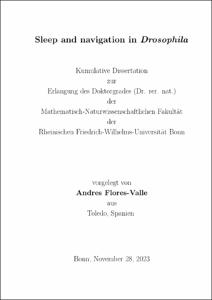Sleep and navigation in Drosophila

Sleep and navigation in Drosophila

| dc.contributor.advisor | Pankratz, Michael J. | |
| dc.contributor.author | Flores-Valle, Andres | |
| dc.date.accessioned | 2023-12-20T17:17:12Z | |
| dc.date.available | 2023-12-20T17:17:12Z | |
| dc.date.issued | 20.12.2023 | |
| dc.identifier.uri | https://hdl.handle.net/20.500.11811/11204 | |
| dc.description.abstract | Sleep plays an essential role in life and is critical for the optimal functioning of the brain, for example in learning and memory. Drosophila displays many of the signatures of sleep observed in mammals or humans, including sleep homeostasis. Sleep homeostasis tracks the accumulating need to sleep during wakefulness, thus investigating sleep homeostasis will provide insights into why sleep is necessary for optimal brain function.
In the fly brain, a neural control circuit for sleep homeostasis has been located in the central complex, a brain region important for navigation and spatial or visual learning. Since the same brain area is involved in sleep, navigation, and learning, it provides the opportunity to investigate the connection between sleep and navigation, as well as the influence of sleep on spatial and visual learning, at the level of well characterized, genetically identified neural circuits. To investigate this relation between sleep, navigation, and memory, this thesis first implements theoretical and computational models, which predict autonomous activity in the head direction system of the fly during sleep. Then, methods for improved imaging in behaving flies are developed. These methods include a setup for (semi-) automated dissection of flies, feeding, and imaging over multiple days during behavior; a method for volumetric imaging at high frame rates; a method for correction of brain motion during imaging; a novel virtual reality setup for learning in head-fixed walking flies; and finally a setup for combined two-photon imaging and learning behavior. The developed techniques are applied for the investigation of sleep homeostasis in neurons and glia. In particular, it is found that ensheathing glia, a type of glia in the fly brain, encode sleep need through their calcium dynamics with the dynamics expected of a sleep homeostat. Additionally, the dynamics of a neural population in the central complex that is modulated by feeding are reported. Finally, a neural population that encodes the traveling direction of the fly navigating in virtual reality is investigated. This neural population is found to exhibit autonomous activity when the fly is resting or sleeping, similar to activity observed in the head direction system in mammals. Overall, the methods developed here have a range of potential applications in monitoring brain dynamics in flies over long timescales or during learning. By applying these methods, this thesis contributes to an understanding of sleep regulation and navigation in the central complex by clarifying the role of previously studied neurons important for sleep, by discovering a sleep homeostat in ensheathing glia, and by describing the autonomous dynamics of neurons in the head direction system during rest and sleep. | en |
| dc.language.iso | eng | |
| dc.rights | Namensnennung 4.0 International | |
| dc.rights.uri | http://creativecommons.org/licenses/by/4.0/ | |
| dc.subject | Neurowissenschaften | |
| dc.subject | Drosophila | |
| dc.subject | Schlaf | |
| dc.subject | Navigation | |
| dc.subject | neuronale Schaltkreise | |
| dc.subject | Neuroscience | |
| dc.subject | sleep | |
| dc.subject | neural circuits | |
| dc.subject.ddc | 570 Biowissenschaften, Biologie | |
| dc.title | Sleep and navigation in Drosophila | |
| dc.type | Dissertation oder Habilitation | |
| dc.identifier.doi | https://doi.org/10.48565/bonndoc-190 | |
| dc.publisher.name | Universitäts- und Landesbibliothek Bonn | |
| dc.publisher.location | Bonn | |
| dc.rights.accessRights | openAccess | |
| dc.identifier.urn | https://nbn-resolving.org/urn:nbn:de:hbz:5-73338 | |
| dc.relation.doi | https://doi.org/10.1371/journal.pcbi.1009088 | |
| dc.relation.doi | https://doi.org/10.1016/j.jneumeth.2021.109432 | |
| dc.relation.doi | https://doi.org/10.1364/OE.27.012147 | |
| dc.relation.doi | https://doi.org/10.1364/BOE.445775 | |
| dc.relation.doi | https://doi.org/10.1016/j.jneumeth.2022.109657 | |
| dc.relation.doi | https://doi.org/10.1101/2022.07.07.499175 | |
| ulbbn.pubtype | Erstveröffentlichung | |
| ulbbnediss.affiliation.name | Rheinische Friedrich-Wilhelms-Universität Bonn | |
| ulbbnediss.affiliation.location | Bonn | |
| ulbbnediss.thesis.level | Dissertation | |
| ulbbnediss.dissID | 7333 | |
| ulbbnediss.date.accepted | 06.11.2023 | |
| ulbbnediss.institute | Angegliederte Institute, verbundene wissenschaftliche Einrichtungen : Stiftung caesar | |
| ulbbnediss.fakultaet | Mathematisch-Naturwissenschaftliche Fakultät | |
| dc.contributor.coReferee | Kerr, Jason | |
| ulbbnediss.contributor.orcid | https://orcid.org/0000-0003-0830-1126 |
Files in this item
This item appears in the following Collection(s)
-
E-Dissertationen (4465)




